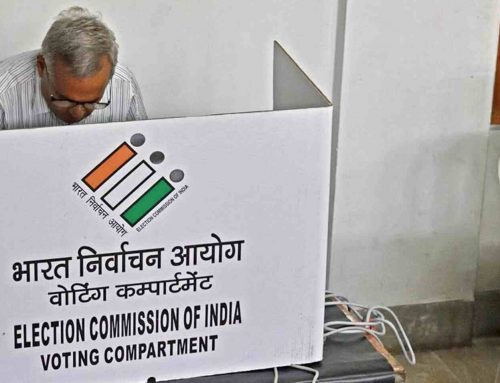Religious tourism forms a major portion of the tourism sector in India today. Some of the largest such destinations also happen to be in ecologically sensitive areas, such as the various religious shrines and destinations in the state of Uttarakhand. The Char Dham Yatra, for instance, puts serious pressure on the tourism infrastructure of the Garhwal region. This pressure, coupled with the monsoons and infrastructure development in and around the shrines, has led to landslides, which threaten valuable human lives. In addition to this, such ‘development’ also has the potential to upset the ecological balance of these areas, which may lead to further challenges in the future. Considering that large sections of the local population depend on the tourism sector for their livelihoods, a growth in the number of tourists has historically been seen to be beneficial for the immediate economic interests of local people. On the flip side, the ever-growing pressures on the local ecology and the growing scale of natural disasters in the area also have the potential to drive tourists away in the future and erode any financial gains made in the lead up to this. What steps can be taken to achieve a balance between the promotion of religious tourism, and preservation of the ecological balance in the state of Uttarakhand?
Most of the landslides are very complex and due to various reasons. These reasons may be true slides, rock fall, slumps, earth floods, or collapse features associated with the road-cut or road work. According to Sanjay Tewari, a very famous geologist working in Czech Republic, some of the very important factors responsible for landslide incidents in Uttarakhand are speedy deforestation on hill slopes, overgrazing on slopes, obstructed or blocked drainage by construction activities. It is found that on most of the slide faces the vegetal cover is almost nil. Only on those slides, which are fossil slide, or in process of stabilising sparse herbs and shrubs are found. It confirms that trees control erosion on slope, to stabilise landslide scars, and to absorb debris flow impacts. A comprehensive policy needs to be framed for checking the landslides that not only cause damage to the eco-system but also interrupt human activities. The Geological Survey of India, premier organisation of earth science studies in the sub-continent, should be involved to tackle the problem. The government’s decision to create ‘green belts’ for forest protection is also a welcome step as under this scheme plans are afoot to regenerate forests with the varieties of flora. It is hoped that the plans to constitute the wildlife police stations on the outskirts of the national park would also help stop a spate of attacks on elephants and tigers inside the sanctuaries and parks like the Jim Corbett National Park. As a major ecosystem representing the complex and inter-related ecology of our planet, mountain environments are essential to the survival of the global eco-system. Mountains are, however, vulnerable to human and natural ecological imbalance. The Himalaya represent one of the most fragile mountain eco-systems and, furthermore, sustain a large human population. This sets them apart from the Alpine or other ranges, where the human habitation is not so high. They and their people deserve consideration and attention, so that their local knowledge can be utilised, so that sustained and accelerated development becomes a reality for them while ensuring promotion and protection of the eco-system as a whole. The role of International Centre for Integrated Mountain Development located in Kathmandu, in generating and strengthening the knowledge about ecology and sustainable development of mountain eco-systems has been recognised in Agenda 21, which calls on the national governments and international organisations to support it. Sustainable development initiatives must respect communities’ dignity and culture, reflect local priorities and perceptions, make full use of positive local knowledge, skills, resourcefulness and insights, and take into account the needs of the most vulnerable sections of the community. Given the larger structural forces that are increasingly impinging on highland communities, one of the central challenges of economic and social development is how to diversify opportunities, and, address the needs of a wide spectrum of groups within communities, whilst at the same time minimising the marginalising aspects of change. Concern for sustainable development and conservation action is strong amongst mountain communities. There is, in addition, a vibrant activist tradition on which such initiatives can build. However, this can only be authentically developed by i) a commitment to decentralising the planning process. An important step is to create a set of policy guidelines to be integrated into economic and social policy and planning at the local levels, and which will be designed to identify needs, priorities and constraints of the Uttarakhand communities. Therefore, there an urgent need for a comprehensive ecological strategy for one of the most fragile ecosystems i.e. Uttarakhand.
The Ajanta-Ellora caves near Aurangabad in Maharashtra are some of the best examples of India’s rich history. Rock cut monastery-temple complexes; they are about 2500 years old and contain some wonderful examples of the art and architecture of the time. However, since they attract so many visitors, there is also constant damage to the caves from the thousands of people who visit every day. A few years ago, Maharashtra Tourism Development Corporation (MTDC) decided to take action to protect the caves, and sanctioned copies of caves to be made at a cost of several crore rupees. It was believed that building such replicas would reduce the footfall to the actual caves and help with easier maintenance. However, unlike the intended use, the replica caves have turned out to be an abysmal failure. Part of the reason is because they are located too close to the actual caves, thus motivating people to visit the actual caves as opposed to the replicas. They are also a constant drain on the exchequer and by some estimates cost more than the actual caves to maintain. Taking this as a case study, kindly research further and answer the following questions. Kindly cite your sources of research while answering.
i) From the perspective of both increasing tourism and conserving the actual cave, highlight some of the major mistakes made with the project and explain why you think these replica caves were a failure. What do you think needed to be done differently in order for such replica caves to be a successful part of the tourism industry?
ii) Having too many tourists visiting can be detrimental to several tourism destinations. This serves up a situation where the development of tourism appears to be facing a ‘lose-lose’ situation. Not having enough tourists visiting can result in too little revenue for those in tourism industry, but having too many visiting can cause irreparable damage to the attractions that draw tourists in the first place. This is the case with Ajanta-Ellora amongst several other spots. The constant flashing of cameras, the hordes of people who walk through the caves every day, the chances of vandalism, all contribute to chances that these fragile artworks may be destroyed, and that this may lead to lower numbers of tourists actually visiting the caves. Do you think it is necessary to limit the numbers of tourists visiting some of these ‘must-see’ destinations? What steps can be taken to maintain a balance between encouraging tourists to visit, and ensuring that their activities do not damage the very destinations that draw them to visit?
i) There are few good reasons for the lack of tourist interest to the replicas. First, the replicas is not even looking like the original real cave. When we see it from some distance, it is looking like a factory. It is looking very bad and ugly. It is not even matching with the landscape. Second, the replica structures are constructed very near to the real caves. The replica of Ajanta cave is just four kilometres from the original cave, and the replica of Ellora is at a mere distance of 500 metres. There is no reason for tourists coming from faraway places to visit the replicas. If the replicas were constructed in Aurangabad or another metro, it would have attracted some more visitors and performed better. According to Experts, there are more things to worry. For the construction of the replicas, there was an extensive use of Thermocol, an inflammable material. In fact, a layer of thermocol is used along with wire meshes and layered with Ferro cement, for the construction of replicas. The idea was to recreate the rough look of a cave wall. Thermocol has been used to create walls, pillars and ceilings and various figurines. Despite its advantages, polystyrene is brittle and flammable. It could also attract rats. But the replicas are a disappointment. One of the reasons why the replica seemed like a good idea was that visitors to the caves were never allowed to get too close to the priceless and fragile art works inside or photograph them. But visitors to the replicas too are asked to stay away from the installations.
ii) Before entering the sites, tourists have to be apprised the importance and value of theses heritage sites and how the tourists can help in preserving the long heritage and pass it onto future generations. Water leakage and damages caused to the painting by lightings are the major and alarming issues in the caves. Diverting the water leakage and the flow of water can help and save the ancient paintings from damages caused by the leaking water. Using Fibre Optic Lights, instead of normal lightings can help. According to ASI, “For the sites which fall under the project of Ajanta Ellora Conservation and Tourism Development Master Plan, A Panel of Experts (POE) consisting of four Indian and four international experts has been constituted by the Ministry of Tourism (MoT), Government of India (GOI) and Japan International Cooperation Agency (JICA) as advised by the UNESCO, for the smooth implementation of conservation packages and for ensuring quality of conservation.”
The value of advertisement, publicity and marketing in the development of tourism:
There was a research exploring two of the basic tools used by tourism marketers: advertising and publicity. Results of the study show that publicity, in either presentation or sequencing, created significantly higher mean scores than advertising for credibility, message strength, and purchase intent. This study reaffirms that publicity is an important element in the tourism marketing mix. Furthermore, it suggests that a publicity-then-advertising strategy is most effective at persuading potential tourists to visit a specific destination. Theoretically, marketing strategy is useful in targeting and developing new market segments and also helps to improve poor public relations which occurred as a result of several unfortunate events. Thus, for a destination to gain from the global tourism share, as evident in the present age, the conscious creation and marketing of place products must be held sacrosanct. In effect, these products in other words known as tourism products are important for destination marketing as they influence people’s perception of the place and can affect their choice and behaviour towards the place.
The various stakeholders in tourism activities and the role played by each stakeholder:
Stakeholders in the tourism industry are a) the communities: It includes Local community groups, Native and cultural groups, Traditional leaders, Private sector employees, Property and building owners (might live in the community or might be outsiders, and Tenants. Successfully planning for tourism development requires the active support and involvement of the local community. b) Public Sector: It includes Municipal authorities, Regional authorities (e.g., planning areas, conservation authorities, coastal zone, regional parks, authorities), National (and State, Province, County, Departments or equivalent) ministries responsible for tourism and its key assets, Other ministries and agencies in areas affecting tourism (e.g. transport, natural resources, environment, culture, infrastructure, planning, heath, etc), Agencies with an interest in the planning or maintenance of specific attractions (e.g., parks, protected areas, museums, marketplaces, cultural sites and events). Participation of governmental and public sector is not only essential but also inevitable in tourism development. Public sector is involved with creation of an institutional framework for tourism development as well as formulation and implementation of policies that aim at increasing the sustainability and attractiveness of tourism destinations. c)Private Sector: It includes Tour operators and travel agents, Accommodation, restaurants and attractions and their associations, Guides, interpreters and outfitters etc. Private sector is essential for the improvement in Quality Standards in Tourism Services. It facilitates in improvement of the overall quality of products and services within the tourism industry (all tourism-related accommodation, restaurants, tour guides, tour operators, and other tourism related service providers) and raise the levels of demand nationally, regionally and internationally. d) NGOs: It includes Environmental groups (in the destination and outside but with an interest), Conservation groups (e.g., wetlands, native species, parks, cultural heritage) etc. NGOs have become influential development actors in the developing world over the last two decades and are becoming increasingly involved in sustainable activities. h) Tourists: It includes Individual and group tourists, International tourism bodies, etc. Tourists are the endpoint of any tourism planning or management strategy. They are the final target group towards whom any destinations is slated to be catered and promoted.







Leave A Comment